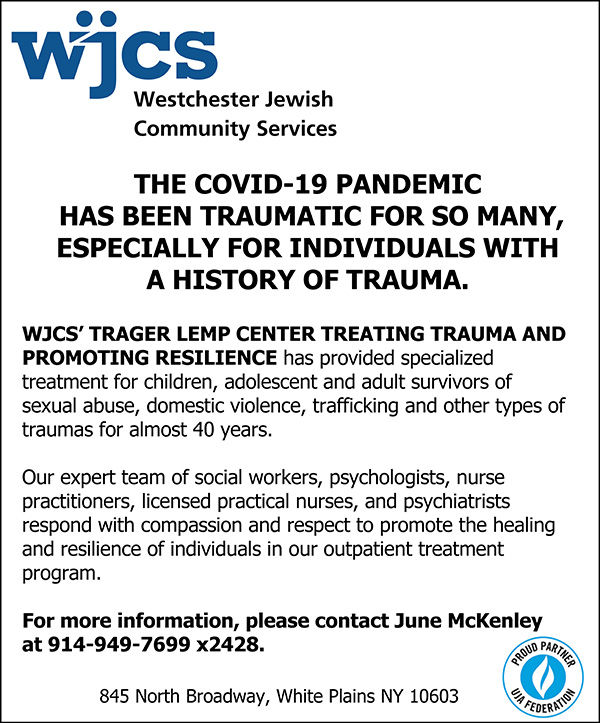No amount of education, training, or clinical experience could have prepared us, as therapists, for the reality of collective trauma on a global scale. As clinicians at the largest provider of community-based outpatient mental health services for our county, Westchester Jewish Community Services (WJCS), we did what everyone else did in March of 2020. The vast majority of us dutifully left our clinics, barricaded ourselves in our homes, and booted up our laptops for working remotely, while others continued to work in the field and do what was needed to keep our clinics open and operational. What we became aware of, what we witnessed – what we treated – over the subsequent 18 months was often devastating.

Our clientele constitutes a racially and ethnically diverse group of individuals, the largest contingent of whom are underserved—effectively a microcosm of those most negatively impacted by the pandemic on a national scale. Indeed, only 6 months into the pandemic we surveyed a small sample of our clients (N = 128) and found that 45% had undergone a change in household income, 15% were living with someone who had contracted COVID, and 25% had experienced the death of someone close to them from the virus.
As an agency and as therapists, we attempted to navigate not merely effectively transitioning to telehealth, but effectively transitioning to telehealth in the context of our clients’ stark pandemic-related adversities. We embraced flexibility and creativity, we improvised, and we had numerous ongoing discussions about the process of therapy under these circumstances. We talked a lot about how: how to do ADHD interventions that facilitated remote learning with children whose families couldn’t afford laptops; how to tackle depression arising in response to the confluence of job loss, mounting debt, and necessary social isolation; and, how to counsel someone who was deprived of the opportunity to say goodbye to a loved one and subsequently prohibited from arranging a funeral—how to sit with someone in their grief when the conduit of your presence was a 5-inch mobile screen.
Like everyone else, we adapted. In accordance with WJCS’ commitment to programmatic research and self-evaluation, after the agency had been providing remote services for a full year, we surveyed our clinicians regarding their experiences with telehealth. In addition, we assessed the ways our clinicians had been personally impacted by the pandemic, and their current burnout. Resulting from prolonged interpersonal stress in the context of one’s job, burnout is a syndrome characterized by debilitating exhaustion, feelings of profound ineffectiveness, as well as cynicism and disconnection (Maslach & Leitner, 2016). The phenomenon of burnout is familiar to all mental health professionals. The term itself is often invoked as a caution, presented as the culmination of a therapist’s failures to engage in self-care, set appropriate boundaries, and maintain work-life balance—provisions rendered near-impossible at various points during the pandemic. Related, we wondered about the blurring of personal and professional roles for our clinicians and the multitude of responsibilities many were now juggling from home, an inevitability of lockdowns and pandemic restrictions.
We targeted all clinicians who were providing individual mental health treatment remotely, achieving a participation rate of just under 70% (N = 61). The vast majority of our clinicians (85%) identified as female and most (80%) were working full-time for the agency. On average, our clinicians were responsible for treating 29 individual clients (SD = 13) per week and had 14 years (SD = 11.9) of experience in mental health. Among the small subset of participants who completed the personal impacts section of the survey (n = 38) more than one year into the pandemic, 29% of our clinicians reported having had COVID, 34% lived with someone who had COVID, and 29% had someone close to them pass away from the virus. We are unsure how representative this is of our clinicians at large, as we cannot extrapolate from this data. It is plausible, for example, that clinicians who elected not to complete this portion of the survey did so because they didn’t deem it relevant to them. With regard to personal roles and responsibilities, just over half of participating clinicians had children living at home (n = 31), the majority of whom were either too young for school or attending school remotely. A number of parent clinicians endorsed difficulties scheduling clients due to their children’s pandemic needs. Moreover, 65% of parents described an increase in childcare since the onset of the pandemic with 20% of them devoting more than 10 additional hours to childcare each week! Further, 16% of our clinicians identified as the caretaker for an older adult or individual with disabilities living in their homes.
As a function of increased time and obligations at home, many therapists reported that lines demarcating their personal and professional lives had blurred. Sixty-nine percent agreed that this was an overt difficulty for them, while additional evidence of boundary blurring was apparent in clinicians’ behavior. The vast majority (77%) reported forgoing sick leave they would have otherwise taken to continue working from home while ill, and two thirds took substantially less vacation time than they generally would. In addition, therapists coped with an increase in behavioral health challenges among their clients. Relative to pre-COVID, 90% of clinicians endorsed that their clients had more severe symptom presentations (to a varying degree). Given that clinicians are being impacted by the pandemic both directly (e.g., becoming sick, losing a loved one) and indirectly (e.g., loss of childcare, less in-person contact with social supports), while simultaneously counseling clients through it, it is hard to imagine them not being burnt out. And indeed, on the abbreviated version of the Maslach Burnout Inventory (MBI-9; Maslach, 1993), the most widely used and well-validated measure of burnout, 71% of our clinicians scored as experiencing high burnout in at least one of the three independent dimensions of burnout (depersonalization, emotional exhaustion, and lack of accomplishment).
Unfortunately, the findings of our survey contribute to a recent litany of articles implying that burnout is the current reality for the vast majority of mental health practitioners in the U.S. While addressing a problem of this scale warrants more than trite aphorisms about not filling from an empty cup, empirical evidence does suggest that therapists tend to be bad at self-care. So rather than espouse the need for such, perhaps, at the present moment, it is more appropriate to recommend that we, as therapists, give ourselves grace. Indeed, I suspect that some of the factors that have made this transition so difficult for us are the same ones that have enabled us, as providers, to survive it. Included among them is some degradation of personal and professional boundaries. Many of us have found ourselves in telehealth interactions that belie the professional doctor patient relationship structure. And that may be a good thing. Perhaps allowing clients a small window into the reality that despite our experience and our credentials, we, too, are just trying to figure out how to endure this – often messily – is therapeutic. Undoubtedly the pandemic has humanized us all.
Despite the myriad ways their lives have been altered by the pandemic and their current degree of burnout, WJCS clinicians assessed telehealth quite positively. Among our clinicians, 75% reported they made the transition to telehealth with ease, and 94% described the technology as easy to use. As an avenue for treatment, 92% felt that telehealth made therapy more accessible to clients, 96% reported no difficulties in adapting the way they typically conduct adult therapy to telehealth, and 76% agreed that telehealth is as helpful as face-to-face sessions for adults. In fact, 66% of clinicians reported enjoying telehealth as much as conducting sessions in person.
Although many of us anticipated an urgent demand from patients and practitioners alike to be back in our offices for face-to-face treatment, the survey responses showed that both clinicians and clients truly like telehealth. In fact, when asked about future treatment preferences, 75% of our clinicians indicated a desire to pursue a hybrid model of care, including some days in the clinic and others administering telehealth from home. Should this positivity be reflected across therapists and practices, telehealth is likely to endure long past the conclusion of the pandemic, serving as a mainstay in the provision of accessible mental health treatment. In the meantime, we will all continue to navigate this new normal.
Kelly Daly, PhD, was a psychology fellow at Westchester Jewish Community Services (WJCS) from 2020-2021. Elana Spira, PhD, is Director of Research at WJCS. To learn more about WJCS, please go to wjcs.com.







